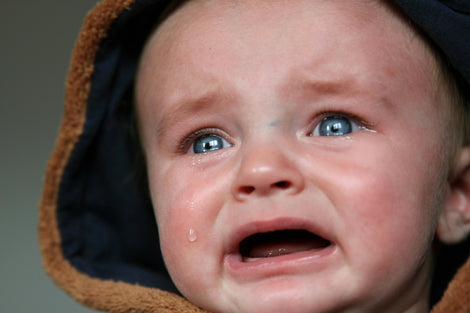The Ultimate Teething Q&A: Real Answers for Curious Parents
Teething can be a tender time—for babies and parents alike. Over the years, we've gathered countless questions from our beautiful community about the signs and symptoms of teething, the best natural teething remedy and what to expect during the different stages of teething. In this blog post, we’re answering them all. Whether you're wondering what's normal, what’s not, or which old wives' tales to leave behind, this guide is here to bring clarity, calm, and confidence to your teething journey—naturally.
- What are the stages of teething?
- What are the signs and symptoms of teething?
- How do I ease teething pain?
- Can teething cause high temperatures?
- Can my baby get a teething rash on their face or body?
- Can teething cause diarrhea?
- Can teething affect my baby's sleep?
- Is it normal for my baby to refuse food or feedings while teething?
- Is rubbing and pulling ear and teething related?
- Is a teething cough normal, and are teething and runny nose related?
- Is my baby's bad breath related to teething?
- How long does teething pain last?
- How long does teething last?
- What is the best natural teething remedy?
- Is it alright to give my baby medicine for teething pain?
- How can I help my baby sleep better during teething?
- Can I use essential oils for teething pain?
- How do I help my teething toddler?
- Is it normal for teeth to come in crooked or with gaps during teething?
- When should I start cleaning my baby's teeth?
- When should I take my baby to the dentist?
-
What should I do if my baby’s teeth haven’t appeared by a certain age?
What are the stages of teething?
The order in which a baby’s teeth come in can vary slightly, but they generally follow this pattern:
- Lower central incisors (bottom front teeth) – Around 6 to 10 months
- Upper central incisors (top front teeth) – Around 8 to 12 months
- Upper lateral incisors (teeth next to the front teeth on top) – Around 9 to 13 months
- Lower lateral incisors (teeth next to the front teeth on the bottom) – Around 10 to 16 months
- First molars (back teeth used for grinding, top and bottom) – Around 13 to 19 months
- Canines (pointy teeth between the incisors and molars, top and bottom) – Around 16 to 22 months
- Second molars (back molars, top and bottom) – Around 25 to 33 months
By age 3, most children will have all 20 primary (baby) teeth. However, every child is different, and some may get their teeth earlier or later than average. (Teeth.org.au: https://www.teeth.org.au/babies-and-toddlers)
What Are the Signs and Symptoms of Teething?
Every baby is different, but here are some common signs and symptoms that may indicate teething:
-
Swollen or tender gums – You may notice redness, puffiness, or slight swelling where the tooth is coming in.
-
Increased drooling – Teething often triggers excess saliva, which can also cause a mild rash around the mouth or chin.
-
Fussiness or irritability – The discomfort of teething can make babies more cranky or difficult to soothe.
-
Chewing on objects – Babies instinctively chew to relieve pressure on their gums, whether it’s their hands, toys, or anything they can reach.
-
Changes in feeding – Some babies may nurse or bottle-feed more for comfort, while others may pull away due to gum pain.
-
Disrupted sleep – Teething discomfort often causes more frequent night waking or difficulty falling asleep.
-
Ear pulling or cheek rubbing – Pain can radiate to the ears or jaw, so babies might tug at their ears or rub their face.
-
Mild temperature rise – A slight increase in body temperature can happen, but a high fever (over 38°C or 100.4°F) is not typical of teething.
-
Looser stools – Some parents report looser nappies during teething, possibly due to swallowed drool, though evidence is mixed.
-
Change in behaviour – Your baby may be clingier, need more cuddles, or seem different from their usual self.
If symptoms seem severe, such as a high fever, persistent diarrhoea, or an unusual rash, it's best to consult your healthcare provider for guidance. (WebMD)
How Do I Ease Teething Pain?
Teething can be a tough time for little ones—and for parents, too. As those tiny teeth push through tender gums, babies often experience discomfort, irritability, and disrupted sleep. The good news is there are gentle, effective ways to ease teething pain and help your baby feel more comfortable through this natural (but sometimes bumpy) stage of development.
One of the simplest and most effective methods is using cold to numb the gums. Chilled (but not frozen) silicone teething toys, a clean, cold washcloth, or even cold purees like applesauce or yoghurt can offer soothing relief. The cool temperature helps reduce inflammation and dull the ache. Gently massaging your baby’s gums with a clean finger or a soft silicone brush can also be incredibly calming, especially just before naps or bedtime.
Distraction and comfort are just as important as physical relief. Extra cuddles, gentle rocking, and offering your baby something safe and interesting to chew on can help shift their focus away from the discomfort. For toddlers, involving them in choices—like picking which teether or snack to use—can also give them a sense of control and reduce frustration.
In some cases, over-the-counter pain relief like infant paracetamol or ibuprofen can be helpful, especially if your baby is struggling to sleep or seems particularly uncomfortable. Always follow age-appropriate dosing guidelines and consult with your doctor before giving medication. It's also best to avoid teething gels containing benzocaine or lidocaine, as these can be harmful to young children.
Most importantly, remember that teething is temporary. With your patience, love, and a few tried-and-true remedies, your little one will make it through—and those first toothy smiles will be well worth it. (Mayo Clinic)
Can teething cause high temperatures?
While a slight fever and teething often go hand in hand, high fevers are not typically associated with teething. If your baby's temperature soars above 38°C, it's more likely because of an illness, so medical attention is recommended. Other symptoms that should not be attributed to teething are: loss of appetite, coughing, rashes, diarrhea, vomiting and seizures.
Pregnancy, Birth and Baby advises, "Teething is not usually associated with illness. So don’t assume that your baby is ‘just teething’ if there are symptoms such as coughing, rashes, diarrhoea, vomiting, seizures, or a high fever of 38°C or more." (Pregnancy, birth and baby)
Can my baby get a teething rash on their face or body?
Can teething can cause a rash? Yes, a teething rash is most commonly found around a baby’s mouth, chin, and cheeks. This happens due to excessive drooling, which is a natural response to teething. The constant moisture on the skin can lead to irritation, redness, and even small bumps, often referred to as a "drool rash." In some cases, the rash can also extend to the neck, chest, and even stomach if drool or moisture is left to sit on the skin for long periods. While teething itself does not directly cause a rash on other parts of the body, some babies may develop a mild rash elsewhere due to increased saliva or sensitivity.
To help prevent and manage drool rash, gently wipe your baby’s face with a soft, dry cloth throughout the day, especially after feeding or when drool is excessive. For drool rash treatment, gently pat your baby's skin dry throughout the day and apply a protective barrier, such as petroleum jelly or a baby-safe moisturizer, to prevent irritation. Using soft, absorbent bibs and changing them frequently can help keep the area dry. If the rash becomes red or irritated, a fragrance-free, hypoallergenic lotion can soothe the skin. Avoid harsh soaps or wipes.
Most drool rashes clear up on their own with proper care, but if the rash becomes severe, appears infected (with pus, crusting, or swelling), or spreads to areas not typically associated with drooling, consult a doctor. In rare cases, what appears to be a teething rash may be a sign of another skin condition, such as eczema or an allergic reaction, so it’s always good to seek medical advice if you are unsure.
Can teething cause diarrhea?
The association between teething and diarrhea is a topic of debate among parents and healthcare professionals. While many parents report changes in their baby's bowel habits during teething, medical experts suggest that teething is not typically linked to symptoms like diarrhea. For instance, Healthy WA states, "Teething should not cause severe illness. If your child has a fever or diarrhoea, see your doctor." (Healthy WA)
Can teething affect my baby's sleep?
Teething can disrupt your baby's sleep due to gum discomfort as new teeth emerge. Signs like increased irritability, restlessness, and waking during the night are common during teething periods. Many babies experience disrupted sleep patterns during teething as the pain and discomfort can make it harder for them to fall asleep and stay asleep.
Is it normal for my baby to refuse food or feedings while teething?
Yes, it is completely normal for babies to refuse food or feedings while teething. The teething process can cause swollen, tender gums, making sucking on a bottle or breast, or chewing on solids, uncomfortable or even painful. Some babies may become fussier during mealtimes, take shorter feedings, or completely refuse certain foods they normally enjoy. This is usually a temporary phase and should improve once the tooth has emerged.
To help your baby continue eating and stay hydrated, try offering cooler, softer foods that are gentle on their gums. Chilled purees, yoghurt or mashed bananas can be soothing, while frozen fruit in a mesh feeder provides relief and nutrition at the same time. If your baby is breastfed or bottle-fed, you can try offering a cold teething toy or gently massaging their gums before feeding to numb the discomfort and encourage them to latch. Some babies may prefer drinking from a cup or sippy cup instead of sucking from a bottle during this time.
It’s also important to follow your baby's cues and avoid forcing them to eat. If they are refusing solids, focus on keeping them hydrated through breast milk, formula, or small amounts of water if they are over six months old. Offering smaller, more frequent meals rather than full feeds may also help. If your baby continues to refuse food for an extended period, shows signs of dehydration (such as fewer wet nappies), or appears to be in severe discomfort, consult your doctor to ensure they are getting the nourishment they need. (healthline)
Is rubbing and pulling ear and teething related?
Yes, rubbing and pulling ear and teething often go hand in hand, as teething pain can radiate to the ears due to the close connection between the gums, jaw, and ear nerves. Since babies may not understand where their discomfort is coming from, they often instinctively tug at their ears or rub the sides of their face to find relief. This behaviour is particularly common when molars are emerging, as these larger teeth create additional pressure on the jaw and surrounding areas.
However, while ear pulling is a frequent teething symptom, it’s important to rule out other potential causes. Ear infections can also lead to ear tugging, and unlike teething, they are often accompanied by other symptoms such as fever, congestion, excessive crying, difficulty sleeping, or fluid drainage from the ear. If your baby seems unusually irritable, has a persistent fever, or shows additional signs of illness, it’s best to consult a doctor to determine whether teething is the cause or if medical attention is needed. (healthline)
Is a teething cough normal, and are teething and runny nose related?
Teething itself does not directly cause a runny nose or teething cough, but some babies may develop mild cold-like symptoms around the time their teeth start coming in. This is because teething can lead to increased drooling, which may cause slight irritation in the throat, leading to a mild cough. Additionally, the process of teething can cause gum inflammation, which may lead to a slight increase in mucus production, contributing to a stuffy or runny nose. However, these symptoms are usually mild and short-lived.
If your baby has significant congestion, a persistent or wet-sounding cough, fever over 38°C, or other signs of illness, it’s important to consider that a viral infection, such as a cold, may be the cause rather than teething. Teething symptoms tend to come and go, while illnesses often worsen over time and may be accompanied by additional symptoms like loss of appetite, difficulty breathing, or extreme fussiness.
To help ease your baby’s discomfort, you can wipe excess drool regularly, use a humidifier to keep the air moist, and offer plenty of fluids to prevent dehydration. If your baby’s runny nose or cough lasts longer than a few days, worsens, or is accompanied by other signs of illness, consult a doctor to rule out infections such as the flu or respiratory viruses. (healthline)
Is my baby's bad breath related to teething?
Yes, many babies will experience bad breath while teething, though it is not a direct symptom of teething itself. The most common reason for bad breath during teething is excessive drooling, which creates a moist environment in the mouth that can encourage bacterial growth. When saliva pools in the mouth or on bibs and clothing, it can lead to an unpleasant odour. Additionally, as babies explore their surroundings by putting objects in their mouths, bacteria can build up on their gums, tongue, and any emerging teeth.
Another possible cause of babys bad breath is gum inflammation. As new teeth push through the gums, irritation and mild swelling can occur, sometimes trapping food particles or bacteria. If your baby has started eating solids, leftover food in the mouth, combined with reduced saliva flow during sleep, can also contribute to bad breath. Less commonly, bad breath may be a sign of an underlying issue, such as oral thrush, reflux, or a respiratory infection.
To help reduce bad breath, keep your baby’s mouth clean by wiping their gums and tongue with a damp cloth or using a soft baby toothbrush if teeth have already emerged. Encouraging them to drink water after meals (if they are over six months old) can help wash away food particles. If excessive drooling is causing the odour, frequently changing bibs and keeping their mouth area dry can help. However, if bad breath persists, worsens, or is accompanied by other symptoms such as fever, swollen gums, or white patches in the mouth, consult a doctor or dentist to rule out any underlying conditions.
How long does teething pain last?
Teething pain varies from baby to baby, but it typically lasts for about a week per tooth—starting a few days before the tooth emerges and continuing for a few days after. Though often a number of teeth may emerge in quick succession, making teething seem like an endless battle for your little one. (Health Direct)
How long does teething last?
Teething typically begins around 4 to 6 months of age and continues until about 2 to 3 years old, when all 20 primary (baby) teeth have fully emerged. The timeline can vary from child to child, with some babies starting as early as 3 months or as late as 12 months. The entire teething process occurs in stages, with different types of teeth appearing at various times.
By the time a child reaches 3 years old, they should have their full set of baby teeth. At this stage, teething symptoms subside until around 6 years old, when the process of losing baby teeth and growing permanent teeth begins. Regular dental check-ups and proper oral hygiene from an early age help ensure healthy teeth and gums throughout this process. (Raisingchildren.net.au)
What is the best natural teething remedy?
The best natural teething remedy often depends on your baby’s age and preferences, but a few tried-and-true options are widely recommended by both parents and health professionals. One of the most effective and gentle approaches is using cold to numb the gums. A chilled silicone teether, a clean cold washcloth to chew on, or even cold purees like applesauce or yoghurt (for babies on solids) can offer soothing relief.
Another excellent natural remedy is gum massage. Gently rubbing your baby’s gums with a clean finger applies counter-pressure to the sore area, which many babies find calming. Some parents also find success using natural rubber or wooden teething rings that are free from harmful chemicals and dyes.
For added comfort, skin-to-skin contact, babywearing, and extra cuddles help regulate your baby’s emotions and make them feel safe and supported through the discomfort. While teething can be tough, these simple, natural approaches can go a long way in easing your baby’s pain—without the need for medication. If your baby seems especially unsettled or you're unsure what's safe, a chat with your pediatrician can offer reassurance and guidance. (Mayo Clinic)
Is it alright to give my baby medicine for teething pain?
Giving your baby ibuprofen or panadol for teething pain can be an option, but it should be done with caution and under medical guidance. Over-the-counter pain relievers like infant paracetamol or ibuprofen can help ease discomfort, but they should only be used according to the recommended dosage and age guidelines. Avoid using teething gels that contain benzocaine or lidocaine, as these can be harmful to infants. Before giving any medication, it’s best to try natural teething remedies like chilled silicone teething toys, gum massages, or cold washcloths. If your baby’s discomfort is severe or persistent, consult a doctor to discuss safe pain relief options. (Mayo Clinic)
How can I help my baby sleep better during teething?
Teething can make sleep difficult for babies due to gum discomfort, increased drooling, and general fussiness. Many babies struggle to settle at bedtime or wake up more frequently throughout the night when a new tooth is coming in. While this phase can be challenging, there are several ways to help your baby sleep better during teething.
One of the most effective strategies is to soothe their gums before bedtime. Offering a cold teething toy, a chilled washcloth, or gently massaging their gums with a clean finger can help numb the discomfort and make it easier for them to relax. If your baby is old enough for solid foods, chilled purees or yogurt before bed can provide comfort while also easing teething pain.
A consistent bedtime routine can also help your baby feel more secure and ready for sleep, even when they are teething. A warm bath, a gentle gum massage, soft lullabies, and cuddling before bed can signal to your baby that it’s time to rest. Using a humidifier in the room can keep the air moist, which is helpful if your baby has a teething cough or mild congestion from teething and a runny nose. (healthline)
Can I use essential oils for teething pain?
Some parents turn to essential oils for teething as natural way to help ease pain and discomfort, but it’s important to use them safely and correctly. Certain essential oils, like chamomile, lavender, and clove oil, are believed to have soothing or anti-inflammatory properties that may help relieve discomfort. However, essential oils should never be applied directly to a baby’s gums, as they are highly concentrated and can cause irritation or even toxicity if ingested. Instead, they should always be properly diluted and used externally in a safe manner.
A gentle way to use essential oils for teething relief is by diluting a small amount with a carrier oil (such as coconut or almond oil) and massaging it on the outside of your baby’s jawline, cheeks, or behind the ears. Chamomile and lavender oils are known for their calming effects and can help soothe fussiness, while clove oil is sometimes used for its natural numbing properties—though it must be heavily diluted, as it can be too strong for babies. Some parents also find relief by adding a drop of diluted essential oil to a warm washcloth and allowing their baby to chew on it under supervision. (John Hopkins Medicine)
While some essential oils may offer mild relief, it’s always best to consult with a pediatrician or certified aromatherapist before using them on your baby. Not all essential oils are safe for infants, and improper use can lead to adverse reactions. If you’re looking for natural teething remedies, cold teething toys, gum massages, or chilled fruit in a mesh feeder are often safer and more effective options for soothing sore gums.
How do I help my teething toddler?
As your child moves into toddlerhood, involve them in the process. Let them choose between different teething toys or decide which frozen fruit they want in their mesh feeder. This sense of control can be empowering during an otherwise uncomfortable time.
To help your teething toddler, emotional support is just as important as physical relief. They may feel confused or overwhelmed by the discomfort, so offering cuddles, calm reassurance, and a soothing tone can make a big difference. Skin-to-skin contact, baby-wearing, and gentle distraction through songs, stories, or play can help ease their distress. Acknowledging their feelings with simple, kind words helps them feel safe and understood. Your loving presence can comfort them through the discomfort and strengthen your bond during this challenging stage.
Every baby is different. What works like a charm for you might be utterly useless for another. Don't be afraid to experiment and find what works best for your little one.
Is it Normal for Teeth to Come in Crooked or with Gaps During Teething?
Yes, it is completely normal for baby teeth to come in crooked or with gaps during teething. In many cases, baby teeth may appear misaligned at first, but they often shift into a better position as more teeth come in and the jaw continues to grow. Gaps between baby teeth are also common and can actually be beneficial, as they allow space for the larger permanent teeth to emerge properly later on.
Several factors can influence how baby teeth come in, including genetics, thumb sucking, dummy use, and even the natural growth pattern of the jaw. Some babies may have teeth that appear tilted or overlap slightly, but this does not necessarily mean they will have long-term dental issues. As your child grows, their jaw will expand, and their teeth may naturally straighten out. (Orthodontics Australia)
However, if your child’s teeth appear significantly misaligned, or if they have persistent issues such as crowding, extreme gaps, or difficulty chewing, it may be worth discussing with a dentist. Early dental visits (recommended around age one) can help monitor tooth development and provide guidance if orthodontic concerns arise. In most cases, baby teeth that come in crooked or with gaps are part of the normal teething process and do not require intervention.
When should I start cleaning my baby's teeth?
It's important to begin oral care for your baby even before their first tooth emerges. Around 3 months of age, start gently wiping your baby's gums with a clean, damp face washer or gauze twice daily. This practice prepares them for future brushing routines. Once the first tooth appears, typically between 6 and 10 months, transition to using a soft infant toothbrush designed for children under 2 years old. Use only water on the toothbrush until your baby is 18 months old, unless advised otherwise by a dentist. Establishing these habits early promotes good dental care practices for life.
Steps to Clean Your Baby's Teeth:
- Positioning: Sit on a bed or the floor with your baby lying down, their head resting on your lap, ensuring both comfort and visibility.
- Secure Hold: Gently cup your baby's chin in your hands, with their head against your body, to keep them steady.
- Brushing Technique: Lift your baby's lip and use soft, circular motions to clean the front and back of each tooth, as well as along the gum line.
To make teeth-cleaning more enjoyable, consider giving your baby an infant toothbrush to play with during bath time, always under supervision. Incorporating songs or allowing them to hold a toy can also make the experience more pleasant. (Raisingchildren.net.au)
When should I take my baby to the dentist?
It's recommended to take your baby to the dentist by the time they're 12 months old or when their first tooth emerges, whichever comes first. Early dental visits allow the dentist to monitor your baby's oral health, provide guidance on proper cleaning techniques, and offer advice on preventing tooth decay. Establishing a dental home early helps your child become familiar with the dental environment, promoting positive experiences for future visits. (Raisingchildren.net.au)
What should I do if my baby’s teeth haven’t appeared by a certain age?
Every baby develops at their own pace, and while most babies get their first tooth around six months, it is common many babies to start teething 3 months earlier or much later. It’s generally not a cause for concern if your baby’s first tooth hasn’t appeared by their first birthday, as delayed tooth eruption can be normal and often runs in families. However, if no teeth have come in by 18 months, it may be worth consulting a pediatric dentist or doctor to rule out any underlying issues.
Several factors can contribute to delayed teething, including genetics, premature birth, low birth weight, or nutritional deficiencies (such as a lack of calcium or vitamin D). In rare cases, conditions like hypothyroidism or developmental disorders may play a role, though most babies with delayed teething will still develop a full set of teeth without any problems.
If you’re concerned about your baby’s teething timeline, you can support their oral development by ensuring they have a balanced diet rich in essential nutrients, offering teething-friendly toys to encourage gum stimulation, and scheduling a dental check-up around their first birthday. A pediatric dentist can assess your baby’s gum and jaw development and provide reassurance or recommendations if necessary. In most cases, delayed teething is simply a variation of normal growth, and your little one’s teeth will appear in their own time. (healthline)
Conclusion
- Teething typically starts around 6 months but can begin earlier or later.
- Common symptoms include drooling, irritability, and a desire to chew on everything.
- Cold items, teething toys, and gentle gum massage can provide relief.
- Avoid teething gels containing benzocaine and amber teething necklaces.
- Teething plays a crucial role in cognitive and physical development.
- Incorporate sensory play to distract from discomfort and promote learning.
- Adapt your teething strategies as your baby grows and develops.
- Every baby is different - be patient and willing to try various remedies.


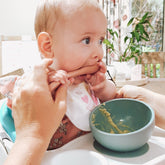

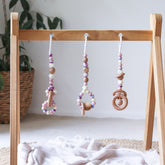

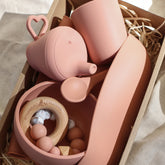

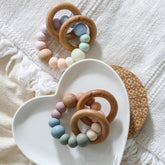

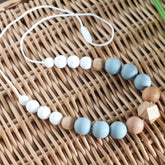

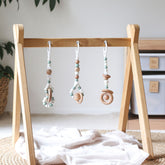

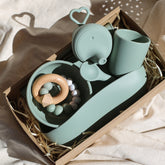

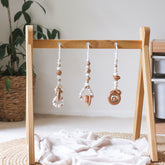





 (
(








